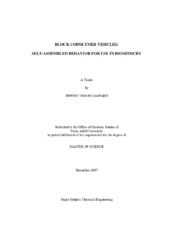| dc.description.abstract | The objective of this research is to investigate synthetic and polypeptide block
copolymers, the structures they form, their response to various stimuli in solution and
their capabilities for use in biomimicry. The self-assembled structures of both polymers
will be used as a basis for the templating of hydrogels materials, both in the interior and
on the surface of the vesicles. The resulting particles will be designed to show the
structural and mechanical properties of living cells.
The synthetic block copolymers are a polyethylene glycol and polybutadiene
(PEO-b-PBd) copolymer and the polypeptide block copolymers are Lysine and Glysine
(K-b-G) copolymers. Investigation of the structures synthetic block copolymers will
focus on whether the polymer can form vesicles, how small of a vesicle structure can be
made, and the formation of internal polymer networks. Subsequent investigations will
look at the needed steps for biomimicry, using the synthetic block copolymers as a
starting point and transitioning to a polypeptide block copolymer.
The Lysine-Glysine copolymers are a new system of materials that form fluid
vesicle structures. Therefore, we must characterize its assembly behavior and investigate how it responds to solution conditions, before we investigate how to make a cellular
mimic from it. The size and mechanical behavior of the K-G vesicles will be measured
to compare and contrast with the synthetic systems.
The goals for creating a biomimic include a hollow sphere structure with a fluid
bilayer, a vesicle that has controllable mechanical properties, and a vesicle with
controllable surface chemistry. Overall, these experiments were a success; we showed
that we can effectively control the size of vesicles created, the material properties of the
vesicles, as well as the surface chemistry of the vesicles. Investigations into a novel
polypeptide block copolymer were conducted and the block copolymer showed the
ability to create vesicles that are responsive to changing salt and pH concentrations. | en |


